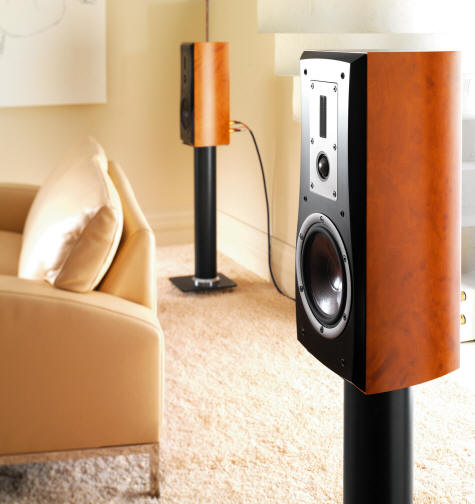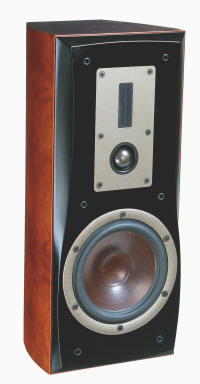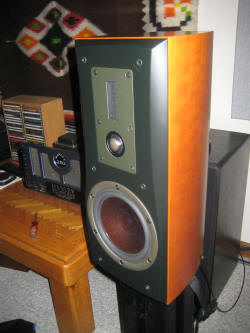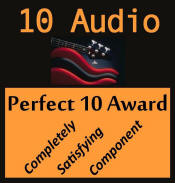What is the highest frequency you can hear? The common belief is that the range of human hearing is from 20 Hertz (cycles per second) to 20,000 Hz. Young people can often hear frequencies at or near 20 kHz, but as we age and our hearing is damaged by years of loud music, gunfire (hopefully from sporting arms), civilization, and possibly vocational noise, our hearing acuity decreases in the upper frequencies. This is not usually a problem for the purpose of listening to music, because as frequency increases, the amount of musical content decreases. Above about 10 kHz, only the upper order harmonics of fundamental notes remain. Nevertheless, these harmonics are critical to hearing the character of the instrument that created the original sound.

Otologists use a steady tone at the frequency of interest to test your hearing. They increase the volume for you and you signal when you can hear the tone. This may be an adequate test of your ability to hear speech, music and other natural sounds at a given frequency, but I suggest that you can hear far higher frequencies than the doctor’s graph of your hearing might indicate. In other words, a hearing test is only partly valid.
What is the frequency of a drum stick hitting the rim of a snare drum? Or a guitar pick touching a string? Or, for that matter, the leading edge of any sound. These impulse sounds do not have a frequency because they are instantaneous. They happen NOW and are gone. There is no note, little tone, and no significant harmonic trail afterwards. If you could put enough of these sounds together to be able to measure on a cycles-per-second scale, the number would be very high. Certainly there could be over 20,000 of these impulses per second, and possibly 50,000 or more. Can you hear the tapping of a stick on a triangle? You bet you can!
The frequency range of the Dali Euphonia RS3 is 64 to 28 kHz. The ribbon “super high-frequency driver” takes over from the dome tweeter at 15 kHz. Even though my normal range of hearing rolls off around that same 15 kHz, the contribution of the RS3’s ribbon tweeter is not only significant, but critically important to hearing the beginning of every single note that the other drivers produce. The ribbon does not sound as if it is contributing very much, however. When I place my ear directly on the ribbon’s metal grille, its output is almost completely swamped by the sound of the dome tweeter just below it on the narrow contoured front baffle. As an experiment, I covered the ribbon driver with acoustic foam and heavy padding to eliminate its contribution to the speaker’s overall sound. The music sounded slow and dull, as if the music’s life and sense of urgency had been drastically reduced. Interesting!

The Euphonia is Dali’s premium speaker range, just below the large and expensive Megaline. The stand-mounted RS3 currently carries a list price of $4,800. It is a sealed box speaker. Please ignore the mention of a “bass reflex tuning frequency” in the specifications. There is no port. I auditioned two different pairs of RS3s: one in the alpi finish and one in cherry. Alpi is an attractive and interesting man-made wood product. The sense of depth in the unique real wood grain can be mesmerizing. The RS3 weighs a very back-friendly 25 pounds. Even though they have two pairs of terminals for bi-wiring, I listened to them single wired with either the included Dali jumpers or Audience Au24 E jumpers. The latter sounded just a bit better, which may be a synergy with my standard Audience Au24 E speaker cables. Installation note: Connect the speaker cables to the tweeter terminals and use the jumpers from those to the woofer terminals. Since the tweeters are higher resolution, give them the direct connection to the amplifier.
The RS3’s sealed enclosure has a bottom end -3dB frequency response of 64 Hz. These two factors make them an ideal candidate for use with a subwoofer or two. A ported speaker has significant audible output from the port, which helps the measured low end response of the speaker. However, the port’s output is slightly out of phase with the woofer’s output which blurs or muddies the sound. The additional phase differences of ported speakers makes achieving a seamless blend with a subwoofer more difficult. The phase control that is included with almost all subwoofers is, unfortunately, almost worthless. A typical installation has the subwoofers close to the wall and the main speakers in front of the subs. This places the sound of the main speaker ahead of the subs in time and, therefore, ahead in phase. The phase control on most subs is actually a delay, postponing the sub’s output. But, and this is a big “but”, in this typical installation, we actually want to advance the sub’s output by a 1 or more milliseconds compensate for the different physical locations of the subwoofer and the main speakers, not delay it further. (A plus 1 ms setting – approximately 3 degrees – would compensate for a difference in the main speakers being located 1 foot in front of the sub.) Please click here for a quick and simple method of setting up subwoofers.
My preference is to use the main speakers full range, without a high pass filter of any kind. No type of filter in the signal path is totally transparent, not even a single capacitor of very high quality. The filter sacrifices some quality of the main speaker. Even if a filter provides some benefits, no amount of signal degradation is acceptable! I have found that a good blend with subwoofers seems to be most achievable if the sub’s transition frequency, and the main speakers -3dB down point, is between about 50 Hz and 100 Hz. Lower than 50 Hz and the detail and continuous dynamic power of the low bass suffers; higher than about 100 Hz and the sub’s output interferes with the lower midrange. Middle-C is a low 262 Hz, so this is a real concern.
The Euphonia RS3s were auditioned with many amplifiers, including the Manley Neo-Classic 250 and Response Audio Bella EXtreme 100 tube monoblocks. In the solid state arena, the BAT VK-220 and VK-250SE, Pass Labs X250.5, Wyred4Sound ST1000, Halcro MC20 stereo amps, a pair of Ampzilla 2000 monos, and, finally, a pair of Marantz MA-9S2 mono amplifiers powered the Dalis. The resolution of the RS3s easily allowed the unique qualities of each amplifier to be heard. Subwoofers employed during the review were my “Perfect Subs”, JL Audio fathom F112, and Velodyne Optimum-12 (review in progress), all used in pairs. The level of low-bass power and whomp of the RS3 without subwoofers is what you would expect from a good 6” woofer, except that a sealed box rolls off at a slower rate than a ported box. Sealed box woofers are sometimes spec’d at their -10 dB frequency due to the slow rolloff. If your room supports it, the RS3 could have usable bass in the 40 Hz range, which can be quite satisfying with some music.
The RS3s can play at any volume I ever want in my 19 x 12 x 8 foot listening room. From soft background to painfully loud, there is no sense that the speaker was either unable or straining to make music. They worked well with the 100 Watt amps mentioned above as well as the more powerful ones. My normal listening volume is in the 3-30 Watt range, providing peaks near 90 dB SPL, based on the readings from the front-panel power meters on Marantz MA-9S2s and a Radio Shack digital SPL meter. One of the attractions of single-driver speakers is the complete lack of crossover artifacts and the Euphonia RS3 shares this character. For over a year I have been attentively listening for any small discontinuity between the woofer and dome tweeter, or between the dome and ribbon tweeters. There was indeed a trace with a pair of new RS3s, and it took a long time to fade away. After about 400 hours of initial use, any failure of the crossover to inaudibly match the three drivers has not been apparent. Some otherwise excellent speakers fail to please in my system for this reason. A result of the perfectly competent crossover is to allow the tonal balance to be completely continuous across the frequency range.
The midrange has the resolution and speed of electrostatic speakers. From Mark Knoffler’s gravelly voice to Sade’s breathy singing, the ability to hear deep into each sound, each inflection and emotion is convincingly life-like. It is easy to hear a singer’s intake of breath, or the air moving through a trumpet, or the resonant vibration of a violin string. Some speakers manage an apparently high resolution character which is ultimately revealed to result from some forwardness in the upper frequencies. A trick, or maybe just clever voicing. With the Euphonia RS3, completely and utterly lacking is any feeling that the upper frequencies are emphasized to add resolution. I find the RS3s to be perfectly neutral overall, certainly never forward nor bright. At the same time, the upper frequency harmonic content of every instrument is presented in such a natural manner, presenting an extraordinary level of micro-detail that characterizing the speaker as warm or rolled off would not be accurate.
The upper midrange and treble are unusually well presented. All three of the drivers are exceptional. The sense of continuousness and cohesiveness is pervasive. The precise relationship between the dome and ribbon tweeters presents the ambiance, air, sense of freedom and relaxed detail that we find in live music. One example is the sound of a tambourine. The Dalis effortlessly offer not only the ringing of the little cymbals, but the sound of the metal contacting each other and the wooden frame. Amazing. If the amplifier is capable, there is a warm but exceedingly present and open sonic picture with a strong sense of a natural 3-dimensional space. The air is crystal clear. It is sunny and the temperature is perfectly comfortable.

Sitting on 22” tall stands, about 3 feet from the wall, toed-in a bit and forming an equilateral triangle with the listening position, the virtual sound stage is very wide and very deep. It is often wider than the speaker locations, and only rarely is the source of the music discernable as originating from the speakers themselves. A common trait of smaller speakers is of a sound stage appearing as a sideways oval, tall in the center and becoming shorter in height at the speaker positions. This change in the front of the stage height is just barely noticeable with the RS3, a benefit of its excellent sound staging ability. This is probably partly due to the contouring of the front baffle. The nicely curved sides of the enclosure help minimize audible cabinet vibrations. There is an attractive black grille which is easily removed for critical listening. The wood finish, whether alpi or cherry, is furniture-grade and beautiful. The RS3s were also designed to offer excellent performance when used as rear speakers in a home theater system, and there is a mounting bracket included that attaches to the rear of the speaker. This speaker is very easy to place in your room and achieve good results.
We are often motivated to replace a component for two reasons: The current model lacks some ability, or it actively offends in one or more ways. It does not do something it should, or does something it should not do. I enjoy trying different components and thereby – hopefully at each substitution – increase my enjoyment of recorded music. The RS3s have been my primary speaker system for about a year and after the somewhat extended break in period, there has been a remarkable absence of desire to replace them. I find their extraordinary resolution, complete lack of emphasis in any particular frequency range, and ability to work well with a wide range of amplifiers to offer a true reference loudspeaker. No other speaker I have heard is tempting me to replace the wonderful Dali Euphonia RS3 loudspeakers.
Overall Rating: 10 LPs

Link to Dali Loudspeakers
10 Audio would like to thank Michael Jensen of Dali USA for his kind assistance with this review.
